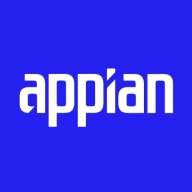

Appian and Nintex Process Platform compete in workflow automation. Appian seems to have an edge due to its comprehensive low-code platform and strong integration capabilities.
Features: Appian offers rapid low-code development, agile real-time data handling, and strong integration, particularly excelling in application development. Nintex is noted for its out-of-the-box integrations, especially within Microsoft ecosystems, making it highly attractive for users in the Microsoft ecosystem.
Room for Improvement: Appian could enhance its user interface customization, mobile capabilities, and integration with DevOps tools. Nintex needs to improve its user interface intuitiveness, error reporting, and customization options.
Ease of Deployment and Customer Service: Appian offers diverse deployment options like public cloud and hybrid models, coupled with responsive technical support. Nintex provides good deployment choices but has a less intuitive on-premises setup; its customer service is serviceable but could benefit from a more customer-centric approach.
Pricing and ROI: Appian's pricing is relatively high, yet justified by faster ROI and process improvements, supported by a flexible licensing model. Nintex's shift to subscription models makes it costly, although local licenses can be cost-effective in certain areas, overall being expensive.
Using Appian is saving us five full-time employees, which is significant since we currently have only four team members.
They see return on investment in terms of cost savings, time savings, more efficient processes, and more efficient employees.
Appian is very efficient, allowing us to build a lot of applications within a financial year, making it cost-effective.
I would give Appian's customer support 10 out of 10 due to their next-level support.
The technical support for Appian rates as 10 out of 10 because they have a great support team.
Their customer service is responsive, and the team is very prompt for support.
I found the support to be excellent with immediate responses whenever I open a ticket.
On a scale of one to 10, Appian rates as a nine for scalability.
Our volume has increased by 20% in the two years since using Appian, and it can handle the increased volume effectively.
Appian is scalable, but it depends on how you build your applications.
Performance issues arise if we have multiple joins within the actions, which definitely reduces the performance.
We have tested Appian during peak usage and off-peak times, and we have not experienced any issues such as lagging or system disruptions.
It depends on how it has been designed and how it has been configured.
The stability of Appian would rate as nine, as it's a stable environment.
Performance issues arise if we have multiple joins within the actions, which definitely reduces the performance.
It has room to improve for use cases where the users are public facing, where anonymous users could come to a site and run a business workflow or interact with some data.
If Appian can suggest the country based on that address, it would significantly decrease error rates in processing remittance.
I would like to see more enhancement in the user interface to allow more freedom in designing the sites and pages.
If we receive data in JSON, there is no action available in Nintex Process Platform to parse the data and extract data from that JSON string.
Additionally, the deployment process should be easier.
Appian provides value for money, is easy to use, has a straightforward setup procedure, and offers great support from the Appian team.
The price of Appian, on a competitive landscape, is a little bit on the higher side for companies, rating maybe a 6.5.
The pricing of Appian is based on the number of users and generally ranges from 70 to 100 USD per user per month.
Nintex Process Platform is expensive.
Appian also utilizes AI for business users, providing a feature called process each view, enabling business users to create their own dashboards, reports, and gain insights from their data and processes using artificial intelligence.
After switching to Appian, it can extract data from MT103, eliminating the need for manual data entry.
The zero-code integration feature is remarkable, allowing for ease of data transfer and workflow enhancement.
We use Nintex Process Platform for process automation.
My team and I created a demo using Nintex, focusing on getting emails, reading, writing, and managing attachments.
| Product | Market Share (%) |
|---|---|
| Appian | 4.2% |
| Nintex Process Platform | 1.7% |
| Other | 94.1% |


| Company Size | Count |
|---|---|
| Small Business | 20 |
| Midsize Enterprise | 9 |
| Large Enterprise | 42 |
| Company Size | Count |
|---|---|
| Small Business | 17 |
| Midsize Enterprise | 6 |
| Large Enterprise | 25 |
Appian is a unified low-code platform and solution used by businesses to build enterprise applications and workflows. This product adapts to the needs of clients and the technologies they are already using to combine their data in a single workflow and maximize resources. The platform has four main components through which it transforms the work process for companies of various sizes. They are:
Appian is utilized across a diverse set of industries, including automotive and manufacturing, energy and utilities, education, financial services, telecom and media, transportation, retail, insurance, healthcare, and life sciences. The most frequent use cases of Appian are customer journey, governance, risk and compliance, operational efficiency, supply chain, distributed order management, and environmental, social, and governance (ESG) management.
Appian Features
Appian has various features that allow users to create solutions for their businesses. These features can be separated into a few groups according to function, including automation, low-code application development, and integrations and data. Some of the most frequently used features of Appian include:
Appian Benefits
The benefits of using Appian include:
Reviews from Real Users
A practice leader - digital process automation at a computer software company values Appian highly because the product is easy to develop, low-code, and has a good user interface.
Alan G., an advisory board member at Codecon VR, Appian offers a clear application life cycle, easy to learn documentation, and comes with a fundamentals course.
Nintex Process Platform offers no/low-code development with system integrations and efficient workflow management, ideal for complex business processes. It's known for its scalable workflows, data management through SmartObjects, and a user-friendly visual designer.
Nintex Process Platform enables organizations to automate processes with ease, supporting electronic forms, digital transformation, and seamless department collaboration. Users on SharePoint and other integrated systems leverage its extensive workflow capabilities for approvals, onboarding, and information capture. While its current framework might benefit from performance enhancements and improved management console usability, it remains a strong choice for providing scalable solutions across industries.
What are the key features of Nintex Process Platform?Companies in sectors like government, HR, and financial services implement Nintex Process Platform for its ability to streamline and connect internal processes. It supports approval workflows, notifications, and data capturing, proving its versatility for diverse business needs. However, challenges with document conversion, performance, and cloud feature parity suggest room for enhancements, particularly in industries handling complex workflows.
We monitor all Business Process Management (BPM) reviews to prevent fraudulent reviews and keep review quality high. We do not post reviews by company employees or direct competitors. We validate each review for authenticity via cross-reference with LinkedIn, and personal follow-up with the reviewer when necessary.